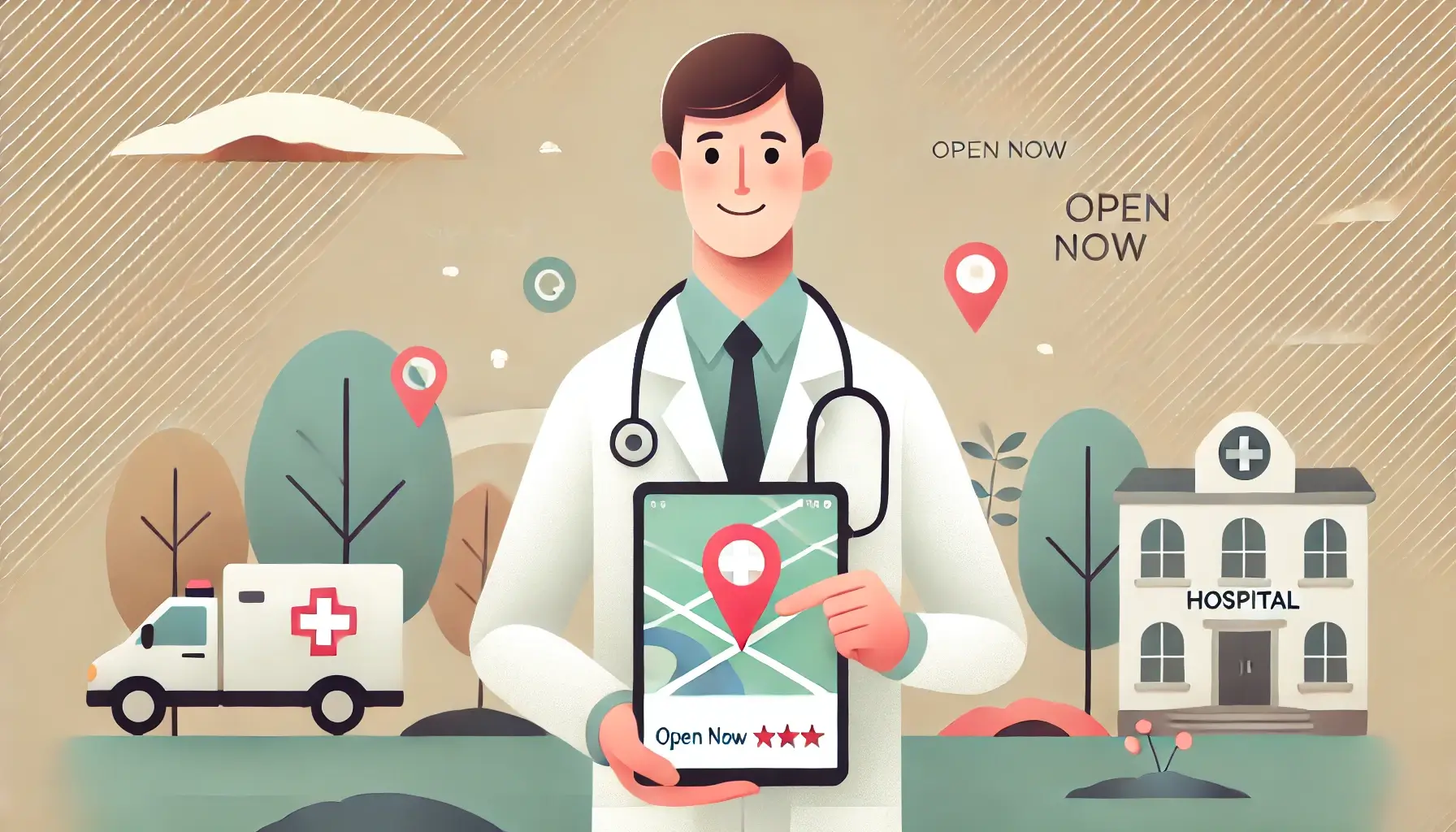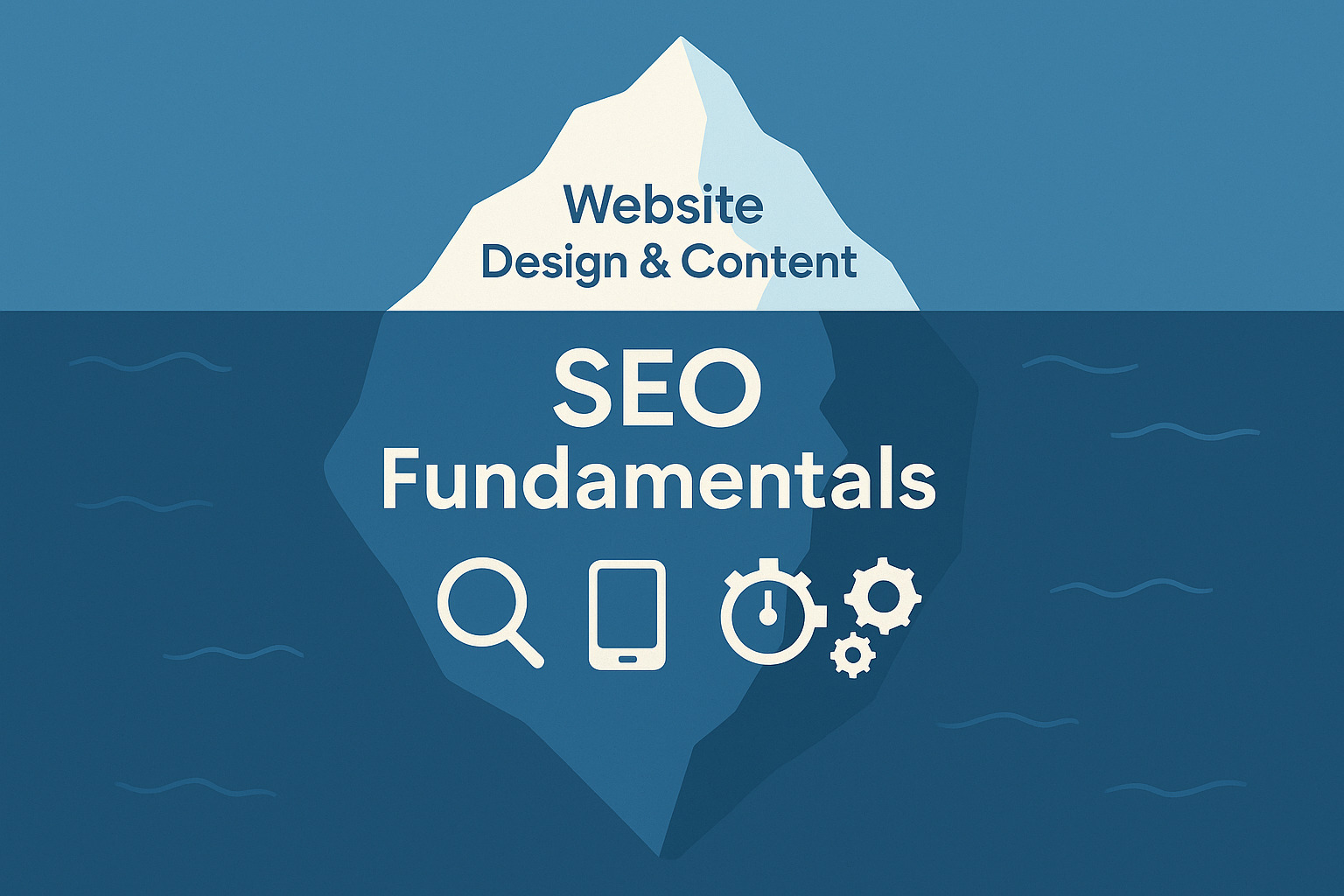The Indian healthcare industry has experienced remarkable growth since the COVID-19 pandemic, with the number of private hospitals rising from around 30,000 in 2019 to nearly 38,000 in 2024. This surge reflects an increasingly competitive landscape, making it more important than ever for smaller hospitals, independent practitioners, dentists, and specialized healthcare providers to gain a strong local foothold.
Today, more people than ever turn to search engines to find local services, healthcare information, and medical providers. If someone types in “gynecologist near me” or “best cancer hospital in Noida” and your hospital’s website or Google Business Profile isn’t among the top results, you’re missing out on valuable patient opportunities.
This is where Local SEO for Hospitals comes into play. A well-crafted healthcare seo marketing ensures that your hospital’s information, reputation, and unique services are easily discoverable online. By optimizing your digital presence, you can elevate your credibility, increase foot traffic, and attract more appointments.
In this blog post, we’ll walk through the key steps to optimize your hospital’s online presence for local SEO. Let’s get started.
1. Setting Up Your Hospital’s Google Business Profile Correctly
The very first step is to have a well-optimized Google Business Profile (GBP) that forms the foundation of your hospital’s local search presence. Your GBP is like a digital signboard or pamphlet that patients can go thorough before they ever step through your doors. Below are some of the key things that you should always take care while optimzing yout GMB profile.
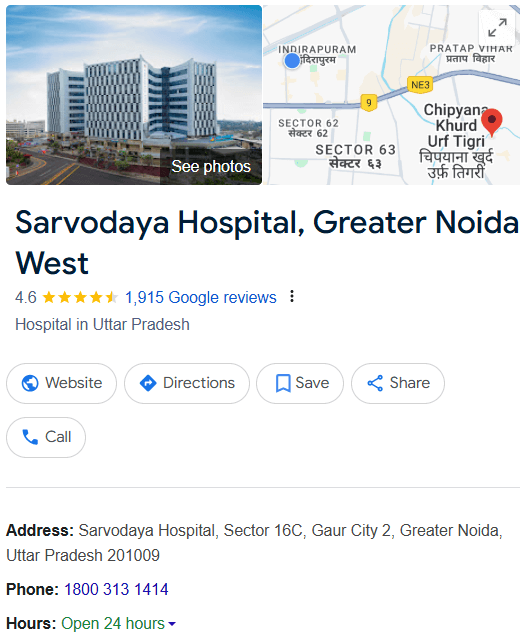
A. Choosing the Proper Listing Name
Your hospital’s listing name should mirror the official name that patients see on your website, signboards, and appointment cards. Avoid the temptation to stuff keywords like “best” or “top” into the name—Google’s guidelines prohibit such promotional additions and could suspend your profile if you break these rules.
Instead, stick to your verified name, such as “ABC Healthcare & Research Center,” and let your credentials shine through in other areas of your profile.
B. Verifying Your Address and Location Details
Start by listing your complete, official address, including any building numbers, floor designations, and recognizable local landmarks if necessary.
If your hospital occupies multiple structures or wings—like a “North Wing” for pediatrics or a “South Block” for cardiology—consider separate listings only if each unit offers distinct, patient-facing services. For large multi-specialty medical centers in metros like Mumbai, clearly labeling each facility helps patients reach the right department promptly.
Keep in mind that Google expects physical authenticity. Avoid PO boxes, virtual office addresses, or any location that doesn’t truly host patient services. Pinning your hospital’s position accurately on Google Maps can further assist patients who rely on navigation apps to get precise directions. Consistent and transparent address details reassure users that they’re dealing with a credible medical institution committed to quality patient care.
C. Selecting the Most Relevant Categories
Categories define what your hospital fundamentally “is” rather than just what it “has.”
Instead of filling this section with every specialty you offer, choose the core category that best matches your hospital’s identity, such as “Multi-Speciality Hospital,” “Maternity Hospital,” or “Eye Care Center.”
Google’s taxonomy is extensive, so pick a category that’s as specific as possible without becoming obscure. For example, “Orthopedic Hospital” or “Cancer Treatment Center” offers a clearer picture than a generic “Health Clinic.”
If there are other organizations on your premises—like a standalone pharmacy or an independent diagnostics lab—they should create separate listings under their own categories. Clear categorization supports better visibility, higher-quality leads, and a more authentic online presence that ultimately leads to enhanced patient trust and stronger local brand recognition.
2. Taking Advantage of Google additional filters or “chips”
While searching for “near me” keywords, you must have seen a series of additional filters or “chips” that users can select to refine their search. In the image below, we see filters like “Within 800m,” “Top rated,” “Open now,” “Walk ins,” as well as specialty-based filters like “Dermatology,” “Urology,” “Neurology,” “Kids doc,” and even “Job.” These filters help users quickly narrow down the results to the most relevant providers based on location, rating, availability, services offered, and other attributes.
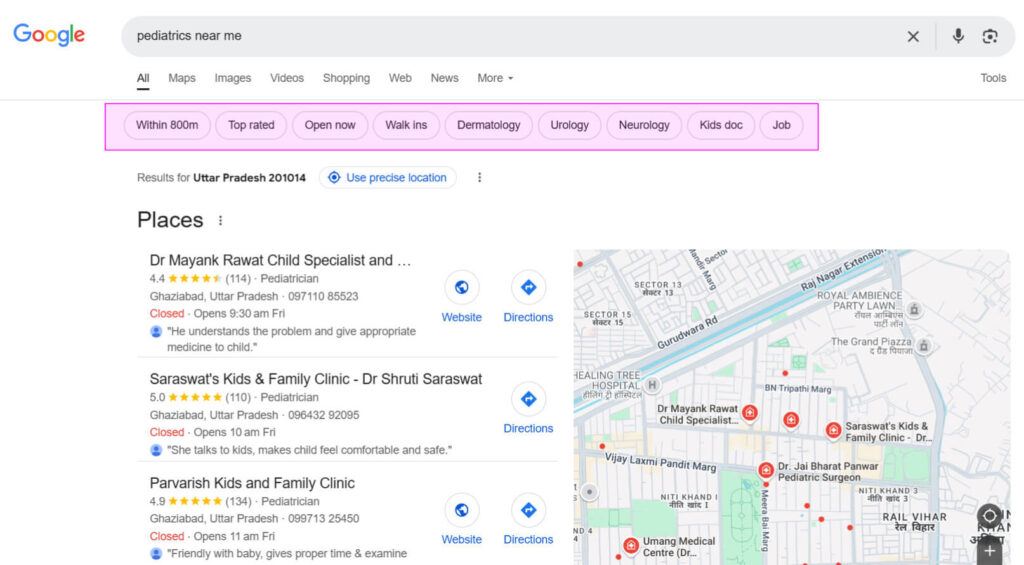
Each of these filters, play a specific role – such as:
- Within 800m: Focuses on distance and hyper-local relevance.
- Top rated: Prioritizes facilities with higher average reviews and better reputations.
- Open now: Displays only those hospitals or clinics currently open, capturing patients who need immediate care.
- Walk ins: Surfaces providers who accept patients without prior appointments, appealing to urgent or last-minute visitors.
How we can optimize the GMB profile for these filters:
- Hours of Operation (Open Now): Make sure your operating hours are correct and frequently updated in your GBP. If your hours differ by day or due to holidays, keep them current. If your facility offers 24/7 emergency services, highlight that.
- Location and Address (Within 800m): Verify your address is accurate and consistent across all directories. This ensures Google accurately calculates the proximity. Adding geocoordinates and embedding Google Maps on your website can help.
- Categories and Services (Dermatology, Urology, Neurology, Kids Doc): Select primary and secondary categories that match your specialties. Use attributes and descriptions to detail the healthcare services and departments you offer. Mention your areas of expertise in your business description and regularly update posts related to these services.
- Attributes (Walk ins): If your clinic allows walk-in patients, add this attribute. Google Business Profile often has attributes you can choose that let users know if you accept walk-ins, offer wheelchair access, have a female doctor on staff, etc.
- Reviews and Ratings: Encourage patients to leave honest, detailed reviews. Positive feedback will help your clinic appear under the “Top rated” filter. Respond to all reviews, both positive and negative, to show you value patient feedback. This we will talk in detail in the next tips.
- Google Posts: Highlight special offers, walk-in availability, clinic tours, “Open now” details, or new specialists who’ve joined your team. Regular updates signal engagement to Google.
3. Harnessing the Power of Patient Reviews and Ratings
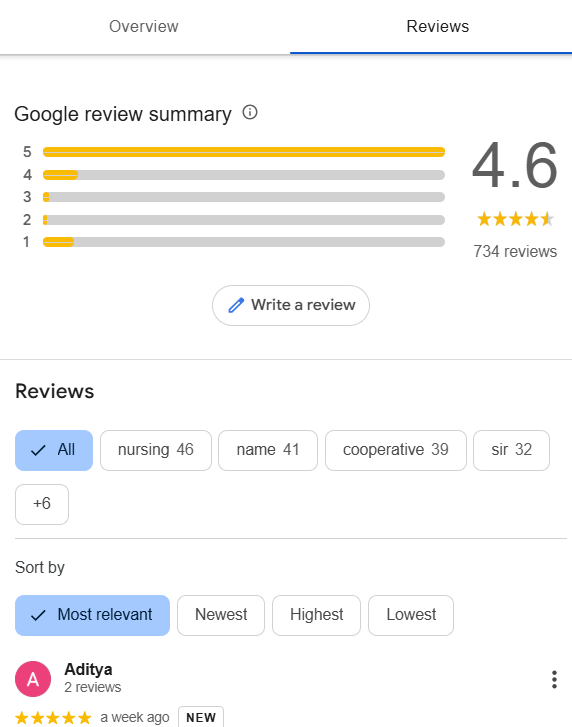
Patients choose doctors and hospitals based on trust and credibility. Online reviews, recommendations, references, word-of-mouth etc. can significantly impact your reputation. While they might not instantly boost your search rankings, genuine patient feedback is more powerful than any marketing campaign.
It’s challenging to gather positive feedback from patients, especially during or immediately after treatment. Hospital visits are often stressful and personal, making it difficult to ask for immediate feedback.
Tactics to encourage more reviews and improve your online reputation
- To encourage timely feedback, consider sending automated follow-up messages via email, WhatsApp, or SMS. Provide a simple link to a review platform, making it easy for patients to share their experiences.
- Train staff to identify patients who have had positive experiences and encourage them to leave a review.
- When you receive negative feedback, respond with empathy and understanding. Reach out to the patient to address their concerns and find a solution. This shows that you value their feedback and are committed to improving patient care.
- Beside, Google My Business, their are many other online platforms in India where patients can leave reviews and contribute to the online reputation of hospitals, doctors, and medical practitioners. You must claim and optimize them. Some of them are:
- Justdial: A popular Indian local search engine.
- Practo: A widely used platform for doctor discovery and appointments.
- Lybrate: Another platform for online doctor consultations and appointments.
- 1mg: Primarily for online pharmacies but also features doctor profiles and reviews.
- Apollo 24|7: The online platform of the Apollo Hospitals group.
- Netmeds: Similar to 1mg, also with doctor listings.
- AskApollo: Another platform associated with Apollo Hospitals.
- Credihealth: Focuses on hospital and treatment information.
- WhatClinic: Global platform, also used in India.
- Facebook Pages: Many hospitals and doctors have Facebook pages where reviews can be left.
- Consumer Complaints Forums: Although primarily for complaints, these can impact reputation. Examples include ConsumerComplaints.in.
- Sulekha: A local services platform that also have medical listings.
4. Optimizing Your Hospital Website for Local Relevance
Your website often serves as the first touchpoint for patients who find your hospital through local online searches. When you streamline it for a geographic specificity—you help potential visitors quickly verify essential details, locate your facility, and take action.
This alignment between your digital presence and your hospital’s on-the-ground reality is crucial for earning trust, boosting engagement, and ultimately converting curious searchers into confirmed appointments.
A. Creating a Dedicated Local Landing Page
Instead of simply linking your Google Business Profile to your homepage, create a specialized local landing page that focuses on your location, core departments, and appointment procedures. It should include directions from key landmarks, local emergency numbers, maps, and nearby public transport details.
This targeted approach not only signals to Google that you’re deeply embedded in your community, but it also provides a clear, concise resource for patients who need fast information before making a trip. Highlighting your hospital’s address, parking options, and visiting hours on a single, easily navigable page helps ensure that the moment someone lands on it, they’re one step closer to trusting your medical services.
B. Ensuring Consistent NAP (Name, Address, Phone Number) Information
Consistency in your hospital’s Name, Address, and Phone number (NAP) is a foundational element of SEO for medical practice. If your printed brochures say “XYZ Heart Care Center,” your website references “XYZ Heart Care & Research Institute,” and your Google Business Profile shortens it to “XYZ Heart Hospital,” you risk confusing both prospective patients and search algorithms.
Choose one correct, official version of your hospital’s name and apply it uniformly across your website, online directories, social media profiles, and appointment-booking portals. Similarly, list the same exact address—right down to the floor or wing number—and maintain one reliable contact number. When Google’s systems see uniformity in your details, they’re more confident in serving your listing prominently to patients who need your healthcare expertise.
C. Streamlining Navigation and Contact Details for Users
User-friendly navigation is non-negotiable. Patients should be able to find what they need—be it a consultation request form, information on specialized treatments, or a route map—in a matter of seconds. Consider implementing a simple menu structure with clear headings like “Services,” “Departments,” “Contact Us,” and “Book an Appointment.”
Prominently display your contact information at the top or bottom of every page, ensuring that your number is clickable on mobile devices. Incorporating a live chat widget or a direct WhatsApp support number can further enhance the user experience, allowing patients to ask quick questions and receive real-time assistance.
5. Highlighting Healthcare Services and Specialties
Your hospital’s online presence should make it easy for patients to understand what you offer and why you’re the best choice for their needs.
Instead of burying vital details deep within multiple pages, bring your top services—such as cardiac surgery, maternity care, orthopedic treatments, or advanced diagnostic imaging—front and center.
By doing so, you help patients quickly identify the areas where your hospital excels and guide them towards the next step: booking an appointment, requesting more information, or visiting your facility.
A. Structuring Service Pages for Better Visibility
A well-organized service page doesn’t just inform visitors; it also signals to search engines what your hospital genuinely provides. Start by creating a main “Services” hub page that lists all your specialties, from “Pediatric Care” to “Oncology Consultations.”
Each listing should link to a dedicated subpage that dives deeper into what makes that particular service stand out—treatment methodologies, state-of-the-art equipment, common procedures, patient success stories, and any unique offerings relevant to local communities in cities like Gurgaon or Pune.
Consistency in naming and terminology is key. If you call a procedure “Laparoscopic Surgery” in one place, use the same term throughout your site and Google Business Profile. This uniformity not only avoids confusion but also helps search engines understand your expertise. When a prospective patient searches for “best laparoscopic surgery in Mumbai,” this cohesive approach ensures your hospital shows up in results, offering them a clear path to learn more.
B. Showcasing Key Physicians and Their Qualifications
In a country where personal trust and credibility matter immensely, shining a spotlight on your doctors can give your hospital a meaningful edge. Devote individual pages or sections to your core medical team, complete with professional bios, educational backgrounds, years of experience, and specialized credentials.
For instance, highlight that your lead cardiologist earned an MD at AIIMS, completed advanced fellowships at reputable institutions, and is fluent in multiple languages—an invaluable asset for connecting with diverse patient populations.
Adding a human touch—friendly headshots, a brief introduction from the doctor, areas of research or notable publications, and even a personal note on why they entered healthcare—can go a long way in making your medical team seem more approachable and trustworthy.
6. Managing Accurate Business Hours and Department Timings
Ensuring accurate, transparent operating hours can deeply influence patient perceptions. When people search online for a nearby hospital, they’re often dealing with immediate health concerns or planning critical appointments. Providing clear, reliable timings for your various departments, clinics, and emergency units helps patients make informed decisions quickly, reducing anxiety and building trust.
A. Setting Clear 24/7 Emergency Service Hours
Many hospitals in cities like Mumbai, Bengaluru, or Chennai run round-the-clock emergency rooms. If your facility offers 24/7 emergency care, make it unmistakably clear on your Google Business Profile and your website.
A bold “Open 24/7 for Emergencies” mention not only reassures patients that critical care is always accessible but also assists Google’s algorithms in accurately positioning your hospital in searches for urgent services.
Consider adding sub-sections on your local landing page that highlight services available at any time—such as trauma care, ambulance availability, and immediate diagnostic support—so that patients know what to expect if they arrive in the middle of the night.
B. Adjusting Schedules for Festivals, Holidays, and Events
India’s rich cultural tapestry means that festivals, holidays, and community events play a significant role in daily life. If your Outpatient Department (OPD) hours change during Diwali, or if certain diagnostic services temporarily close during Holi, update these variations on your online profiles.
Leverage Google’s “More hours” and “Special hours” features to inform patients about any modifications, whether it’s a short-staffed weekend OPD or an extended schedule for vaccination drives during monsoon season.
This level of detail not only prevents frustrated walk-ins but also helps your hospital stand out as responsive, transparent, and patient-centric. When people see you’ve taken the time to adapt and communicate schedules according to local realities, they’re more inclined to trust your services and return for future care.
7. Crafting Locally Relevant and Engaging Content
Connecting meaningfully with your audience means moving beyond generic healthcare advice and shining a spotlight on the issues that matter most to the communities you serve. Providing content tailored to local lifestyles, climates, and patient expectations can help you stand out. Below you can see on such example of post.

By addressing real-world concerns and highlighting tangible benefits, your website and blog become valuable resources—places where patients seek clarity, reassurance, and guidance on their health journeys.
A. Addressing Regional Health Concerns and Seasonal Ailments
Healthcare demands vary dramatically across India’s diverse regions. During monsoon months, cities like Mumbai or Chennai may experience a surge in dengue and waterborne diseases, while colder northern states might see an uptick in respiratory ailments during winter.
Craft blog posts, infographics, or short videos focusing on prevention tips, early-warning signs, and treatment options related to these seasonal health challenges.
Consider titles like “Staying Dengue-Free This Monsoon in Mumbai” or “How to Protect Your Lungs During Delhi’s Winter Smog.” By directly acknowledging local conditions, you position your hospital as an engaged, informed partner committed to safeguarding community well-being.
B. Promoting Local Health Camps, Events, and Check-ups
If your healthcare facility hosts free health camps, vaccination drives, or wellness seminars, use your online presence to spread the word. Highlight the venue (a local park, community center, or even a sister clinic) and include details about screenings or consultations offered.
For example, if you’re organizing a “Free Eye Check-up Camp in Noida’s Sector 18” or a “Women’s Wellness Weekend in Jaipur,” craft posts that provide event dates, services available, and instructions on how to participate. Such localized content helps prospective patients feel personally invited, encouraging them to step forward and engage with your care center’s initiatives.
C. Introducing New Doctors and Facilities Through Storytelling
When a new specialist joins your team or a cutting-edge MRI suite opens at your hospital, don’t just list the change—tell a story. Perhaps your new surgeon trained at AIIMS, developed a passion for pediatric orthopedics during a rural healthcare drive, and now aims to bring the same compassion and expertise to Kolkata. Or maybe your upgraded dialysis unit offers more comfortable seating and shorter wait times, directly addressing feedback you’ve received from patients in Gurugram.
Presenting these enhancements as narratives—complete with relatable experiences and patient-centric improvements—helps build trust and humanize your medical center. Over time, these stories establish your institution not merely as a place of treatment, but as an evolving, caring entity that grows in tandem with the community it serves.
8. Monitoring and Improving Your Local SEO Performance
Achieving strong local search visibility is an ongoing process. To ensure that your hospital continues to appear in front of patients searching for care in your area—you need to actively measure how well your online strategies are working.
It’s not enough to set up your Google Business Profile and service pages once; you must regularly monitor performance and refine your approach to stay ahead of shifting patient needs and ever-changing search algorithms.
A. Tracking Rankings, Traffic, and Patient Inquiries
Start by keeping a close eye on key metrics that matter to your hospital’s long-term success. Use tools like Google Search Console and Google Analytics to see which local search terms are bringing in visitors and which pages are driving the most appointment requests.
Monitor your rankings for region-specific keywords. Paying attention to these insights helps you understand which specialties resonate with patients and where you might need to strengthen your content or services.
Additionally, track the volume and quality of inquiries flowing in—whether they’re phone calls, form submissions, or WhatsApp messages. Noticing trends can guide you in allocating resources and strategizing on what to highlight. If you find that queries for knee replacements spike during certain months, for example, you can prepare content or campaigns around that service to better meet patient demand.
B. Leveraging Analytics to Enhance User Experience and Conversion
Data-driven decision-making can significantly improve how patients interact with your hospital’s online presence. By analyzing user behavior—like how long they stay on a page or at which point they leave the site—you gain clues on what might need improvement.
Perhaps your local landing page would benefit from a simpler navigation menu or clearer directions, or maybe your appointment booking form needs fewer fields to reduce drop-offs. Even subtle changes, like reorganizing content or adding a quick FAQ section tailored to the needs of families in your region, can substantially boost engagement.
Applying these insights fosters a cycle of continuous refinement. As you act on what analytics reveal, patients enjoy a more seamless experience, trust your hospital more readily, and are more likely to choose your facility for their healthcare needs. Over time, these incremental optimizations compound, reinforcing your position as a top local choice in an environment where accessibility, clarity, and comfort make all the difference.
Conclusion
Building a strong local SEO presence for your hospital isn’t just about ranking higher—it’s about meeting patients at their point of need, offering them clear information, and guiding them toward better healthcare decisions. By meticulously optimizing your Google Business Profile, showcasing services and medical expertise, emphasizing patient reviews, and continuously refining your website’s user experience, you create a digital ecosystem that fosters trust, reliability, and community engagement.
These efforts matter because healthcare is personal, urgent, and deeply rooted in trust. Patients want reassurance and credibility before they walk through your hospital’s doors. Implementing these strategies not only positions your hospital as a front-runner in local searches but also enriches patient journeys, strengthens your reputation, and helps ensure that more people in your community receive the quality care they deserve.
